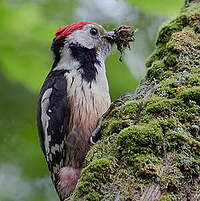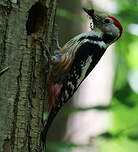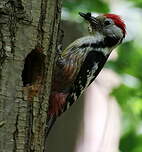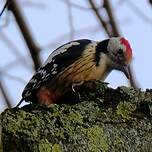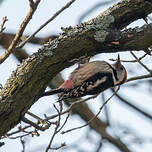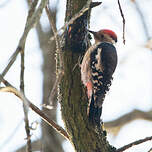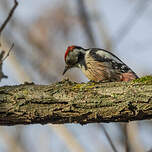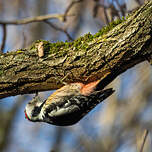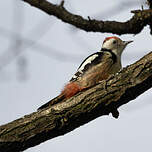Middle Spotted Woodpecker
Dendrocoptes medius - Pic mar
Identification
The Middle Spotted Woodpecker is a medium-sized woodpecker, about the same size as a Great Spotted Woodpecker. As with this bird, it is a multicolored, or 'bigarré' as we used to say, black and white with red. It is mostly associated with deciduous trees.
Sexual dimorphism is very weak. The adult is characterized by its white head topped with a bright vermillion red crown, brighter in males and less in females. This crown is not bordered in black as it is in the juvenile Great Spotted Woodpecker with which it is often confused in summer. The forehead is pale beige. The black patch on the sides of the neck does not reach the beak or the nape, as in the Great Spotted Woodpecker. The bill is significantly weaker than that of the Great Spotted Woodpecker. Another important difference is on the lower side. Whereas in the Great Spotted Woodpecker, chest and belly are plain white, the woodpecker shows fine blackish stripes on these areas. Finally, the lower and central tail feathers, red in the Great Spotted Woodpecker, are more softened and tend to diffuse into a pinkish shade on the belly, especially in males. The chest is tinged russet. 4 subspecies are currently recognized which differ only in minor details of the plumage.
The juvenile resembles the adult, but is more faded, with less contrasting plumage, locally browned white areas, reduced and softer red of the tail feathers, that of the head less bright and limited, etc.
Subspecific information 4 subspecies
- Dendrocoptes medius medius (Europe to w Russia)
- Dendrocoptes medius caucasicus (n Turkey through the Caucasus)
- Dendrocoptes medius anatoliae (w and s Turkey)
- Dendrocoptes medius sanctijohannis (Zagros Mts.. sw Iran.)
Foreign names
- Pic mar,
- Pico mediano,
- pica-pau-médio,
- Mittelspecht,
- közép fakopáncs,
- Middelste Bonte Specht,
- Picchio rosso mezzano,
- mellanspett,
- Mellomspett,
- ďateľ prostredný,
- strakapoud prostřední,
- Mellemflagspætte,
- tammitikka,
- picot garser mitjà,
- Fauskspæta,
- dzięcioł średni,
- vidējais dzenis,
- srednji detel,
- Средний пёстрый дятел,
- ヒメアカゲラ,
- 中斑啄木鸟,
- mellanspett,
- 中斑啄木,
Voice song and call
The cry of the Middle Spotted Woodpecker is a 'pik' that resembles that of the Great Spotted Woodpecker, but is less hard, less resounding, that can be translated as 'puk'. This cry is emitted singly, but very frequently in typical rapid series, without any equivalent for the Great Spotted Woodpecker. In this case, the notes are harder, the first of a slightly higher pitch, kikkukkukkukukkukkuk... and audible from far away.
The Middle Spotted Woodpecker does not drum like most other woodpeckers, but can emit sounds by tapping its beak on the wood around the nest. Due to the absence of drumming, it has developed a territorial song. This song is very particular and rather resembles a raptor's cry. It is a typical series of 5 to 15 sound (typically 12) drawn-out, plaintive and nasal cries, kieinn kieinn kieinn kieinn... at a rate of approximately one note per second.
Any research on forest birds involves a good knowledge of these vocal emissions. The first is often unknown and attributed to the Great Spotted Woodpecker by non-initiates.
Habitat
The Middle Spotted Woodpecker is a bird of the primitive forest. It is attached to old deciduous forests, with a preference these days for pure or mixed oak forests, oak-hornbeam forests, oak-beech forests, and even in the SE of its range, pure beech forest.
It is a bird of the plains, usually found in western Europe below 600 m in altitude. Locally, it can go higher, for example up to over 2000 m in the SW of Iran, the southernmost point of its range.
It is a resident species.
Behaviour character trait
The Middle Spotted Woodpecker is a shy, largely solitary bird that frequents the upper layers of forests where the view does not go far.
If not for its spring vocalizations, it would easily go unnoticed, which is a shame because it is a beautiful bird. It is often sympatric with the more common and visible Forest Woodpecker, and there is apparently no competition between them. Their respective densities can be close, yet it is the Forest Woodpecker that stands out because it is more vocal and noisy at all times. The Middle Spotted Woodpecker takes a back seat. It is more discreet and less frequently strikes trunks and branches and has no forges. Its cry is softer and less common. It also emerges less from the forest environment than the Forest Woodpecker. Its attendance at winter bird feeders is poorly documented and probably depends on the distance to the forest. Fortunately, at the end of winter, it produces vocalizations that allow it to be approached. Adults gather and couples form. At this time of the nuptial parade, it is not surprising to see the couple facing each other and fluffing up the bright red feathers on their head in a stereotyped ceremony. It is then clearly understood the role of these brightly colored feathers.Dietfeeding habits
In the spring, the Middle Spotted Woodpecker is mainly insectivorous. It tends to feed on the upper layers of the forest, avoiding direct competition with the Great Spotted Woodpecker which spends more time feeding on the lower layers.
Its diet consists mainly of arthropods such as beetles, flies, ants, aphids, caterpillars, spiders, mites, etc. Small beetles and ants are the most common adult food items. It is not as eager to look for xylophageous larvae, due to its weaker beak, although the male does it more often near the surface. It also enjoys fruits such as wild cherries, lichens and bark.It would be interesting to know whether the Middle Spotted Woodpecker feeds on Thaumetopoea processionea caterpillars, a major oak forest pest. If yes, considering the situation, neither it nor the rest of the insectivorous birds are able to significantly limit their population.
In the off-season, the Middle Spotted Woodpecker searches for food on bigger branches and trunks while the Great Spotted Woodpecker prefers to search on the ground. Seeds also make a regular part of its food, such as beech nuts, hazel nuts and chestnuts. This may explain why it occasionally visits bird feeders in winter, where fat is also available.
Reproduction nesting
The Middle Spotted Woodpecker is already vocal from March to mid-April. At this time, its plaintive song can be heard in old oak trees. We can imagine the posturing of pairs forming, with fiery red caps erect, and the ensuing chases. Then, once the pair is established, it drills a nest cavity in a dead or decaying tree trunk or branch at heights of 5 to 10 metres, sometimes higher. The chosen tree is often an old oak, but can also be other species such as beech, cherry or white poplar. Both partners participate in this work which can take 2 to 3 weeks. Their beak doesn't possess the power of that of the Great Spotted Woodpecker and they use it with moderation.
Nevertheless, they are capable of drilling through live wood to reach the underlying damaged parts. The diameter of the entrance hole of the nest is 40 to 50 mm and the nest itself can reach a depth of 35 cm. An old nest may be reused if its condition allows it. Very often, the entrance hole is drilled just under a polypore fungus which must initially indicate to the woodpeckers the nature of the underlying wood, and secondarily protect the nest.The laying, single, typically consists of 5 or 6 (4-8) white eggs. Incubation, which is undertaken alternately by the pair, lasts 11 to 14 days. Once the chicks have hatched, the male and female will take turns to incubate the young, feed them once they have gone and collected food, remove their fecal sacks, keep the nest clean, and this until they take flight which occurs 22 to 23 days after hatching. The juveniles will remain under their parents' watch for a further 8 to 11 days before they begin to take distances. They will be suitable for reproduction themselves from the following year.
Geographic range
The Middle Spotted Woodpecker (4 subspecies recognised) has an essentiallly European distribution (subspecies medius), in temperate latitudes, with an extension to the SE towards Turkey (subspecies anatoliae), the Caucasus (subspecies caucasicus) and the Zagros Mountains in Iran (subspecies sancijohannis), thereby also gaining altitude. It is sedentary or at most locally erratic. Variation between the 4 subspecies is largely clinal.
Threats - protection
IUCN conservation status
concern
in the Wild
threatened
evaluated
Middle Spotted Woodpecker is not currently considered threatened by BirdLife International, which estimates that the short-term demographic trend in Europe for 2000-2012 was on the rise. If there is decline somewhere, it is necessarily due to forest management, particularly to the fragmentation of oak forests, to the elimination of old or deteriorating trees, and even more so in a difficult climatic context where summer droughts stress trees and encourage their exploitation, possibly preventively. The future is therefore not necessarily rosy for the Middle Spotted Woodpecker.
Sources of information
- IOC World Bird List (v14.2), Gill, F and D Donsker (Eds). 2024-04-18.
- Atlas des oiseaux de France métropolitaine. Nidification et présence hivernale. , Issa Nidal et Muller Y
- Les passereaux d'Europe, tome 1, P. Géroudet, M. Cuisin
- BirdLife International, BirdLife International
- Birds of the World, The Cornell Lab of Ornithology
- xeno-canto, Sharing bird sounds from around the world,
Other sources of interest
 Specification sheet created on
21/07/2023 by Jean François
Specification sheet created on
21/07/2023 by Jean FrançoisTranslation by AI Oiseaux.net
© 1996-2025 Oiseaux.net
- Accipitriformes
- Aegotheliformes
- Anseriformes
- Apodiformes
- Apterygiformes
- Bucerotiformes
- Caprimulgiformes
- Cariamiformes
- Casuariiformes
- Charadriiformes
- Ciconiiformes
- Coliiformes
- Columbiformes
- Coraciiformes
- Cuculiformes
- Eurypygiformes
- Falconiformes
- Galliformes
- Gaviiformes
- Gruiformes
- Leptosomiformes
- Mesitornithiformes
- Musophagiformes
- Nyctibiiformes
- Opisthocomiformes
- Otidiformes
- Passeriformes
- Pelecaniformes
- Phaethontiformes
- Phoenicopteriformes
- Piciformes
- Podargiformes
- Podicipediformes
- Procellariiformes
- Psittaciformes
- Pterocliformes
- Rheiformes
- Sphenisciformes
- Steatornithiformes
- Strigiformes
- Struthioniformes
- Suliformes
- Tinamiformes
- Trogoniformes















